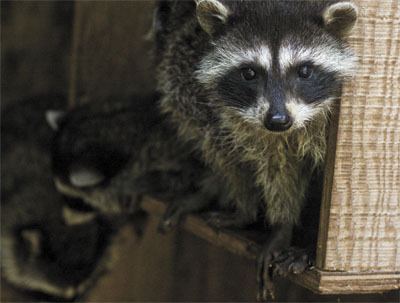There are no bears, wolves or mountain lions on the island. When the sun goes down there is little to fear from the wild world when it comes to large predators. Smaller mammals like the raccoon are wild and can cause problems especially when humans interact with them as if they were domestic creatures.
Although San Juan County does not have an animal control sector, the Sheriff’s Office does handle problems involving “dog behavior- barking, biting, running at large, chasing or injuring/killing livestock, menacing people,” said Sheriff Rob Nou. “On issues like raccoon attacks and/ or problems, we can solicit help from Fish and Wildlife to try to trap and relocate offending critters.”
But Shona Aitken, education coordinator at Wolf Hollow Wildlife Rehabilitation Center, said removing problem animals does not solve the problem.
“If you remove raccoons it creates an open space and other raccoons will move in,” she added.
Adult raccoons weigh 15 to 40 pounds, their weight being a result of genetics, age, available food, and habitat location. Some males have weighed in at over 60 pounds. The average life span of a raccoon in the wild is two to three years. As long as raccoons are kept out of human homes, not cornered, and not treated as pets, they are not dangerous, according to the Washington Department of Fish and Wildlife.
Raccoon populations can get quite large in urban areas, due to hunting and trapping restrictions, few predators, and human-supplied food, according to the USFWS’s website.
Aitken said raccoons often become a problem when they have been regularly fed by humans or when someone who has fed them for ages suddenly stops.
“Then there are a bunch of raccoons with youngsters getting desperate because their usual source of food has disappeared,” she said. “Anyone who has been regularly feeding animals such as raccoons for a long time, should discontinue, very gradually, over the period of several months.”
Another reason for an increase in raccoon activity in residential areas may be the recent spell of hot dry weather, said Aitken, which makes it more difficult for them to find sources of fresh water and juicy food, so yards look even more tempting than usual. Raccoons also are found in areas with their favorite snacks like clams, crayfish, frogs and snails.
This is also baby season, so mom can be protective of her young … and take risks she would not otherwise consider, Aitken said.
Aitken added that the best way to deal with raccoons is to make sure they are not enticed to come onto your property. This can be accomplished in a few steps:
1: Spray your yard and deck with unpleasant scents like coyote urine (available for purchase online), lemon juice or vinegar. If you see raccoons in your yard, spray them with a hose to show them they are not welcome. Installing motion sensors for lights or sprinklers also dissuades the animals from coming near your home.
2: Keep compost, garbage and other food contained. Do not leave your pet food outdoors.
3: Keep pets inside. Dogs and cats can be attacked by a range of wildlife.
Aitken said there is no record of any reported cases of rabies in mammals on the islands, but that doesn’t mean people should not be concerned about wildlife.
“Pet interactions with wildlife happen all the time,” Aitken said. “We feel like we are safe because we don’t have large predators, but it’s a false sense of security.”
Aitken said people are can call Wolf Hollow 378-5000 if they have questions about wildlife. You can also call the WDFW Regional Office at 425-775-1311.



